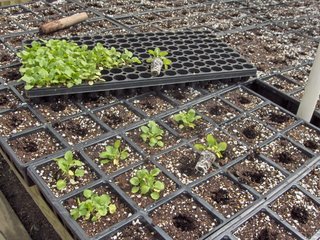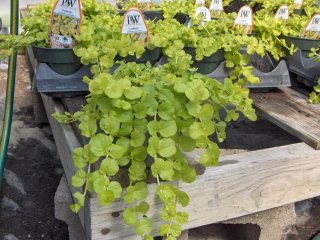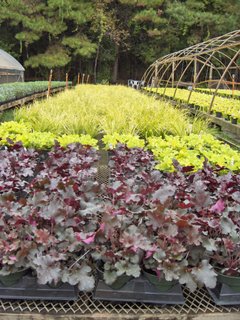Poinsettia Colors
Have you ever wondered how a professional gardener can tell what color a non-blooming poinsettia is? How do we just glance at a plant and say, with confidence, that plant is purple, pink, red, or white?
It's a simple trick that any one can learn. Simply look at the stem of the leaves. They will always be the same shade that the poinsettia is going to turn into. If you are intimately familiar with poinsettias the leaves will also be a hint. For example, Prestige Red has different foliage than Red Velvet. However, for distinguishing the difference between main colors, all you need to do is look at the stem of the leaf.
Some examples are illustrated below:
Prestige Red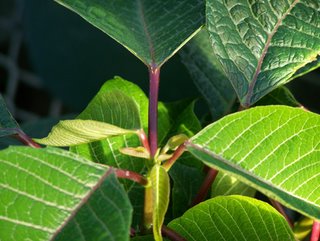
Cortez Burgundy (a plum colored poinsettia)
Snowcap (White)
Enduring Pink
I am not, however recommending the purchase of a poinsettia that has not already started to turn shades. Getting a poinsettia to bloom at home can be tough. They need a certain amount of dark (12 hrs. usually) and even street lights or car lights can play havoc with the plant's need for darkness. On the other hand, if you like to experiment or are an 'old-hat' at raising poinsettias, this tip is an easy insurance that you're buying the correct color.
Gardening and Landscaping by PRWeb
Monday, October 16, 2006
How to recognize Poinsettia Colors...
Posted by
The Plant Pixie
at
10:20 PM
![]()
Thursday, October 12, 2006
Pansy and Viola Flower Gardening

Planting Your Pansies and Violas
If you buy your pansies from a reputable grower pansy care is very easy. Some people prefer to mix bonemeal, bloodmeal, or manure in their flower beds. This is because pansies love nitrogen and iron. Bonemeal and bloodmeal are both nitrogen rich, organic fertilizers. I prefer bonemeal because it slowly releases the nitrogen into your flower bed and is also a good source of organic phosphates. You can still grow beautiful pansies without this step but if you have the energy and time, go ahead. Your plants will thank you.
Ok, our beds are tilled and ready. It's time to plant. If the plants you are planting are root-bound rough up the bottom of the root ball before planting. (Firmly rub your thumb along the bottom of the root ball to break up a few of the roots.) This will help to stimulate growth in the plant. Now dig a hole and plant! The top of the root ball should be flush (level) with the top of your flower bed. Do not plant pansies deep. They will suffocate and die. Lastly, water in your freshly planted bed(s). It doesn't matter if your plants were wet or dry. The goal here is to let the excess loose soil sink into any remaining air pockets around the root system of the plants.
Maintaining your winter garden
Pansies need food and care, like any other living thing. Here you have some choices. Do you like feeding your garden by hand every few weeks or are you a low-maintenance type gardener? If you are one of those who likes to putter in the garden find a good liquid fertilizer that you can apply every two or three weeks. Pansies will accept most basic fertilizers but for a guideline: 15-2-20 is the fertilizer I find works best. The basic 10-10-10 will do in a pinch. If you have granular ironite be sure to sprinkle some around the beds every 3-4 months.
Now, for those of us who prefer low maintenance flower beds, time release fertilizer is the answer. My two favorites are Electra and Florikan. Just sprinkle liberally around the flower bed (on the dirt - not on top of the plants themselves) and allow the rain and/or sprinkler system to do the work for you. Electra should be applied once every couple of months for a fantastic show of color. I'm afraid Florikan is not yet available in the retail market but your local nursery has probably already applied it to their pansy stock.
Lastly, but not least important, for best results you should deadhead your garden once or twice every month. This will keep your plants blooming at their maximum and prevent them from going to seed.
These are the same principals that any professional grower will follow when growing their own pansies/violas for sale. Here are some pictures from the three main stages of my past (2006) growing season for retail sale.
Planting Pansies (Note that these pansy plugs are slightly root-bound and we do rough up the bottoms before planting)
Growing Baby Pansies (2 weeks after planting)
Ready to sell! (2 months later)
Posted by
The Plant Pixie
at
4:19 PM
![]()
Thursday, October 05, 2006
Winter Accent Plants
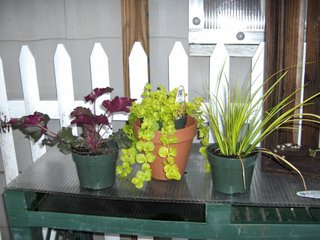
Winter flowers in the southeastern US have traditionally been pansies but in the past few years some exciting new-comers have entered the market. "Proven Winners" has come out with a series called 'Fall Magic' that has some true winners in it. I have been experimenting with these in my own yard for a few years and have a few favorites of my own. My top 4 from this series are Goldilocks, Lavender Cotton, Purple Petticoats and Ogon Grass. Each of these adds a little something different to you containers and/or garden.
A growing new trend is the use of winter snapdragons. These plants usually grow to about 2 feet and bloom in the late fall (Oct-Nov). Snapdragons come in all shades of pink, yellow, white, lavender, and red. Once the flowers die the plant will stay green through the worst of our winter months and began to bloom again in the early spring (late Feb-March). My favorite variety is 'Liberty' which seems to stand up to rust better than some other varieties.
Another choice is the Ornamental Cabbage or Ornamental Kale. These plants come in pink, white and red. While they grow to the same height and width as the edible variety, these are decorative only! The cooler the weather, the more vibrant their colors will become. Cabbage and kale plants not only have a great foliage to add texture but they, like the snapdragon and lavender cotton, will bloom in the spring.
These are, by no means, all of your options for a winter garden. Next time you're shopping for pansies at your local garden center, pause a moment and look around. You might be surprised at all the options available to you!
Posted by
The Plant Pixie
at
8:10 PM
![]()
Sunday, October 01, 2006
An oft overlooked treat
Lavender Cotton (Santolina Chamaecyparissus)
I believe that lavender cotton is an often overlooked and unappreciated plant in our region. This particular plant is usually found in our nurseries in the fall/winter season. However, it is evergreen and just as beautiful in the spring and summer months. The foliage has a greenish - grey tint similar to that of a dusty miller and soft fuzzy leaves . The average plant will only reach about a foot in height but will sprawl out 2-3 feet in length when planted in the ground.
Posted by
The Plant Pixie
at
6:45 PM
![]()







